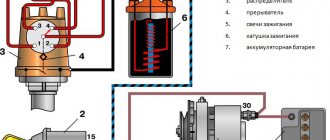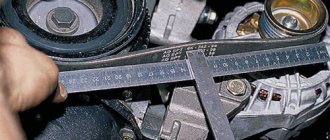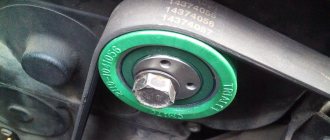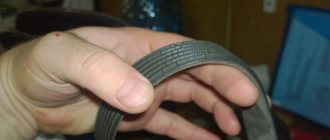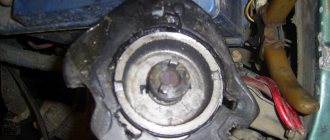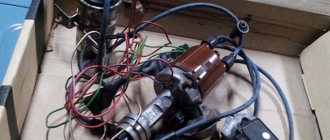Pre-ignition is one of the most common malfunctions of the ignition system of carburetor engines. Its essence lies in too early (sooner than required for normal engine operation) ignition of the fuel in the combustion chambers (much earlier than the piston reaches top dead center).
The initial ignition timing for a specific gasoline is set when the car engine is idling. This advance is necessary for proper engine operation. When it operates under load, even greater ignition timing is required, which is achieved through the operation of centrifugal and vacuum ignition timing regulators. But, if the initial angle is set too early, then the work of the regulators is superimposed on this incorrect angle, making the ignition so early that it leads to big problems in the engine.
Signs of early ignition
Depending on how much the ignition timing has deviated from the norm, signs of early ignition are either practically invisible or visible to the naked eye.
— Problem with starting the engine. The engine does not start the first or second time. There may be reverse rotation of the crankshaft after turning off the ignition.
— The car engine is idling unsteadily. It is impossible to equalize the XX speed with the screws on the carburetor, or the engine runs stably only when the speed is set to higher.
— Sluggish car dynamics at speed. At the same time, starting and accelerating can be quite acceptable, but at speed the engine’s power and throttle response are insufficient (“it’s as if someone is holding the car from behind”).
- “Fingers are knocking.” Constant detonation (fractional, chattering sound from the engine) when the car is moving, increasing when the gas pedal is pressed and does not disappear after it is released.
— The spark plugs are black. Poorly burning fuel deposits black soot on the spark plugs, leading to their rapid failure.
— “Shots” into the muffler when idling. Unburned fuel burns out in the muffler with pops. Misfires due to spark plugs working once.
— Black smoke from the muffler. Unburned fuel smokes.
— Increased fuel consumption. The engine requires a lot more fuel to do its job when the ignition is too early.
The signs of early ignition listed above may be signs of other malfunctions, for example, with the carburetor (“overflows”), the fuel system (the fuel pump pumps too much), the ignition system, etc. But, in any case, when they appear, first of all, check that the angle is set correctly ignition timing, and then we look at the carburetor and everything else.
Causes of early ignition
— The cause of too early ignition is most often an incorrectly set ignition timing at idle speed of the engine. For all recommendations and required ignition timing angles, see the following articles on the website: “Setting the ignition timing on VAZ 2108, 2109, 21099”, “Setting the ignition timing on VAZ 2101, 2102, 2103, 2104, 2105, 2106, 2107” .
— If the initial ignition timing is set correctly, but there are still signs of too early ignition, then you should check the centrifugal ignition timing regulator. It should start working at a speed slightly above idle speed and gradually, depending on the engine speed, increase the angle. Weakening or breaking of the regulator springs can cause the centrifugal regulator to immediately increase the ignition timing to unacceptable values.
— On VAZ 2105, 2107 cars with a contact ignition system, you should check the gap between the contacts of the breaker in the distributor, since its value directly affects the ignition timing.
Notes and additions
— The main check for the presence of early or, conversely, late ignition on VAZ 2105, 2107, 2108, 2109, 21099 cars is a check in motion. When, moving at a speed of 40-50 km/h, on a flat section of the road, we sharply press the gas pedal. There should be a small short-term detonation (fractional, chirping sound from the engine compartment). If it appears and disappears, good, the ignition is set correctly. It appears and does not go away, the ignition is too early. There is no detonation - late ignition.
More articles on the car ignition system
If the ignition on a VAZ 2107 is too late, in which direction should the distributor be turned?
no matter what, use your ear and tachometer to decide! Or better yet, go to a specialist and give him $10!
There is a special device for setting the advance angle, it’s better to go to a service center, you will make a mistake and spend more money on fuel consumption.
more like glow ignition (wrong spark plugs or bad gasoline)
all clear! The slider rotates clockwise, so turn the distributor counterclockwise, which would be earlier and later, which would be later!
How should I know?
Go to the service station, they will put out an instrument, the detonation will torture you by eye and you will burn a lot of fuel.
Moves counterclockwise
Leading the way on domestic cars
A good way to determine whether the ignition is late or early on a VAZ-2106, -2109 is to monitor the operation of a warm engine at idle speed.
It should work smoothly, without dips and not wobble during operation. When the ignition is not correct, it will definitely twitch. This occurs due to the occurrence of reactive moments in the connecting rod and piston group, which are transmitted to the cylinder block. Otherwise, the symptoms are completely the same for all carburetor engines.
How to set the ignition of a VAZ 2106 at home
Poor dynamics, as well as overheating of the VAZ 2106 engine, can be signs not only of a coked engine or problems with the spark plugs, but also indicate an incorrectly set ignition. Sometimes this problem is accompanied by a ringing sound in the engine, which is heard at low as well as medium speeds. Novice drivers, as a rule, have no idea how to set the ignition of a VAZ 2106, so most of them immediately turn to specialists for help. There is no need for this, and today you will see that you can easily set the ignition with your own hands. You don't need any special equipment to work.
Video
The car engine is overheating.
Overheating of a car engine is a problem that every driver can face. In this article we can learn: - how to notice in time that the engine has overheated; — why the engine heats up in general and in certain situations; — what to do if the engine overheats.
To understand the essence of the issue, it is necessary to consistently read all the explanations of an experienced auto mechanic.
ADJUSTING THE IGNITION WITH A TRAMBER. (MANUALLY!) Where to turn it.
In fact, everything is very simple... first you need to find out where the ignition distributor shaft rotates when the engine is running. This is not difficult to do on any make of car; you need to remove the cover from the ignition distributor. and turn the engine with the starter or roll the car by first engaging forward gear. Once the direction of rotation is figured out, adjusting the ignition timing is simply a matter of technique. Turning the distributor body in the direction opposite to the rotation of the runner is a decrease in the ignition timing, and vice versa, turning in the direction of rotation of the runner is an increase in the ignition timing... Now you can spin. boldly
